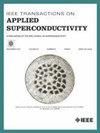Development of a Helium-Free 1.5 T Extremity MRI Magnet
IF 1.8
3区 物理与天体物理
Q3 ENGINEERING, ELECTRICAL & ELECTRONIC
引用次数: 0
Abstract
We report the design, fabrication, and testing of a 1.5 tesla extremity magnetic resonance imaging (MRI) magnet that operates without liquid helium, and cooled entirely by conduction. The magnet employs an 8-coil NbTi superconducting winding on a high-conductivity aluminum former, actively shielded and supported in a cryostat by three stainless steel cantilever tubes for thermal isolation. Thermal links of high-purity aluminum foil ensure efficient heat transfer from the coils to a 1 W cryocooler. Finite element simulations guided the design, predicting a homogeneous field (≈5 ppm peak-to-peak) over a 15 cm field of view and acceptable mechanical stresses in the coils. The fabricated magnet was successfully cooled below 5 K and energized to 1.5 T. After minimal training quenches, it achieved stable operation with a measured field drift on the order of 0.1–0.2 ppm/h. Passive shimming brought the field homogeneity to within 8 ppm peak-to-peak over a 150 mm diameter volume, meeting clinical MRI requirements. These results demonstrate the viability of a helium-free, compact MRI magnet for extremity imaging, representing a significant step toward more accessible and low-maintenance MRI systems.无氦1.5 T肢体核磁共振磁体的研制
我们报告了一个1.5特斯拉的肢体磁共振成像(MRI)磁体的设计、制造和测试,该磁体在没有液氦的情况下工作,完全通过传导冷却。磁铁采用8圈NbTi超导绕组在高导电性铝前,主动屏蔽和支持在低温恒温器由三个不锈钢悬臂管热隔离。高纯度铝箔的热链接确保从线圈到1w制冷机的有效传热。有限元模拟指导了设计,预测了15厘米视野范围内的均匀场(峰对峰≈5 ppm)和线圈中可接受的机械应力。制造的磁体成功地冷却到5 K以下,并通电到1.5 t。经过最小的训练淬火,它实现了稳定的运行,测量的场漂移在0.1-0.2 ppm/h左右。在150mm直径的体积范围内,被动调光使场均匀性达到8ppm以内,满足临床MRI要求。这些结果证明了用于四肢成像的无氦紧凑MRI磁体的可行性,代表着向更易于使用和低维护的MRI系统迈出了重要的一步。
本文章由计算机程序翻译,如有差异,请以英文原文为准。
求助全文
约1分钟内获得全文
求助全文
来源期刊

IEEE Transactions on Applied Superconductivity
工程技术-工程:电子与电气
CiteScore
3.50
自引率
33.30%
发文量
650
审稿时长
2.3 months
期刊介绍:
IEEE Transactions on Applied Superconductivity (TAS) contains articles on the applications of superconductivity and other relevant technology. Electronic applications include analog and digital circuits employing thin films and active devices such as Josephson junctions. Large scale applications include magnets for power applications such as motors and generators, for magnetic resonance, for accelerators, and cable applications such as power transmission.
 求助内容:
求助内容: 应助结果提醒方式:
应助结果提醒方式:


